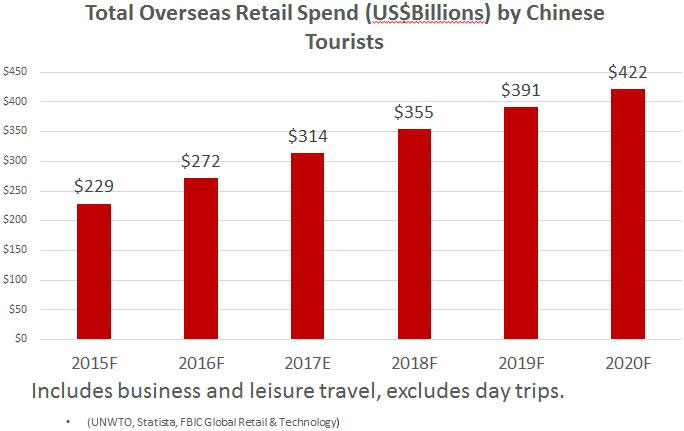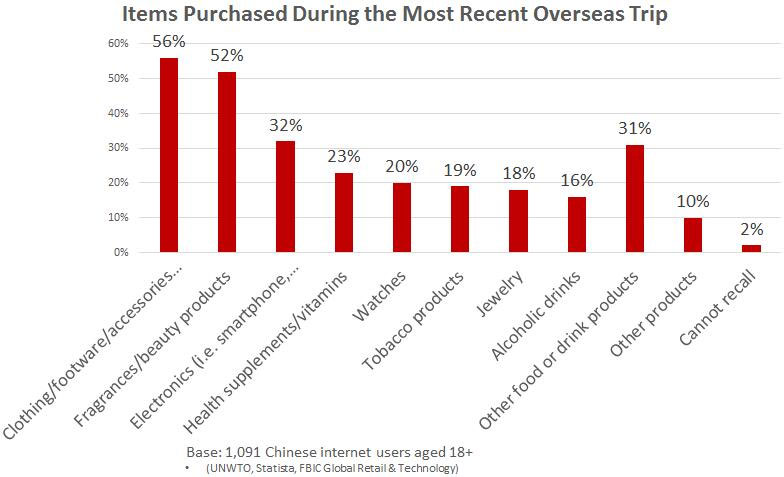Chinese are the world’s biggest overseas spenders, with US$152 billion in overseas spending in 2014. Still, many news stories have recently warned of a slow-down in Chinese spending abroad, especially on luxury items. Rather than becoming alarmed at the decline of Chinese shopping, it is important to understand the complexity of this market and how it is evolving – while some retailers will have to devise new ways to keep the attention of Chinese shoppers, others who might not have expected to benefit from this market could soon do so. It may be changing, but the pie is still big, and there are many ways to get a piece. To start, here are six things you need to understand.
1. Is overseas shopping on the decline or increase?
There is conflicting information about the state of Chinese overseas shopping. Hotels.com’s 2017 China International Travel Market report found that interest in shopping had dropped sharply among Chinese travelers, from 68 percent expressing an interest in shopping in 2016 to just 33 percent in 2017. Interest in experiences seems to be taking the place of shopping, with an 11 percent rise in interest in sightseeing, and a 12 percent rise for eco/green tours. However, these numbers need to be understood within the context of a maturing tourism market, and not necessarily as the end of Chinese shopping – shopping is still 22 percent of the total Chinese outbound travel spend, second only to vacation packages at 48 percent. Don’t forget that the Chinese luxury shopping market barely existed a decade ago, and now represents anywhere from a third to one half of luxury sales.
Despite the CITM survey, many other studies show steady growth that is predicted to continue. The Fung Global 2016 study estimated a 6.3 percent y-o-y growth in overseas retail purchases from 2015 to 2016. Another study by FBIC Global Retail & Technology and China Luxury predicts that Chinese will spend 84% more on overseas retail purchases by 2020 than in 2016. Chinese travelers themselves also predict more shopping in their future – 61 percent of those surveyed in the Fung Global study said they planned to spend more on shopping in the future, and only 17 percent said they planned to spend less. In a 2017 Publicis Media study, 60 percent of affluent Chinese aged 18-45 said that shopping would become more important in their future travels.
Still, even the Fung study warns that there could be stagnation closer to the year 2020, as the Chinese government enacts measures to encourage more domestic spending, more goods become available in China through e-commerce channels, and we see more price harmonization for luxury goods, dampening the motivation to shop abroad. With these factors in mind, however, there is still time for retailers to adapt to ensure that demand stays healthy.

2. Bigger opportunities for smaller places
Growth in Chinese overseas shopping is not uniform around the world. The Fung Global study showed major increases in spend from 2015-2016 in Taiwan (up 70.9 percent year on year) and Hong Kong (46 percent), a moderate 2.3 percent increase for the US, and decreases of 5 percent and 15.8 percent for Thailand and South Korea, respectively. Within one country, there could also be fluctuations that are tied to other trends in Chinese tourism. The rise of adventure and eco-tourism might seem at odds with shopping, but it doesn’t have to be. For example, the Salt Lake City mall, City Creek Center, has been able to capitalize on the rise of Chinese tourists that pass through Salt Lake City on their way to Yellowstone National Park. The shopping center has worked to make itself Chinese-friendly and promote itself to Chinese tourists, with positive results. As Chinese tourism to places like national parks develops further, retailers located in places that might not be seen as first-choice shopping destinations could receive unexpected benefits.
3. High growth potential for niche products
Much of what is written about Chinese overseas shopping centers on luxury items, but the market is much more diverse than that, and varies by country and region. For example, tourists to Japan are most likely to shop at malls, for electronics, and at pharmacies, whereas those in the US shop for software, duty free and at bookstores, and those in Taiwan centre their purchases on clothing, with tailors and women’s clothes in the top shopping categories. One area with room for growth is health – supplements and vitamins are currently purchased by nearly a quarter of Chinese tourists, and among tourists to Taiwan, the percentage has rose from 20 percent in 2015 to 55 percent in 2016. Another growing retail segment for Chinese consumers is activewear, which could overtake the luxury market by 2020 and is a perfect fit for retailers that Chinese tourists might visit en route to national parks or other adventure tourism destinations.
Even in terms of luxury items, shopping is changing quite a bit. Anti-corruption campaigns in China at first benefitted foreign luxury retailers, as Chinese instead traveled abroad to buy their luxury items. However, from September 1, 2017, Chinese banks will be required to report all overseas transactions of RMB1,000 (US$150) or more, in an effort to fight money laundering, terrorism and tax avoidance, and this could certainly have an impact on luxury sales. Of course, not all Chinese shoppers buy luxury goods outside of China to evade anti-corruption efforts – other motivations include much lower prices abroad without the Chinese luxury tax, as well as favorable exchange rates. But luxury retailers are increasingly adjusting prices to avoid this kind of disparity, making luxury shopping at home more appealing for Chinese consumers.
There are other changes for the Chinese luxury market, too. Chinese are now less likely to purchase luxury gifts and more likely to shop for themselves abroad. As the market has matured, they are also less likely to shop for obvious, status symbol items, instead preferring to buy niche items that show off their personal taste and style. But there is still more interest among Chinese tourists in global brand boutiques rather than local designers. This provides a good opportunity for luxury retailers abroad to hang on to their share of the Chinese market by promoting limited-edition, niche items that can only be bought in a specific location. The growing interest in experiences for Chinese travelers also suggests that retailers could maintain and grow sales among Chinese by offering unique shopping experiences that can only be found abroad.

4. Improved payment methods are crucial
The 2017 CITM report identified payment facilities as the area that most needed improvement for hotels overseas. This goes for other businesses as well. At the very least, retailers need to accept UnionPay, the system used for card payments throughout China. But this isn’t enough – retailers will also need to start accepting Chinese mobile payments via Alipay and WeChat Pay. Both systems have proliferated rapidly in China in the last few years, but there is very low penetration abroad. A few major luxury retailers, including Galeries Lafayette, Harrods and Selfridges, got Alipay in 2016, but a lot of catching up is still needed, with 20 percent of Chinese travelers reporting that they have never used a mobile payment abroad. Not only are these payment systems ones that Chinese consumers are comfortable with, but they also tend to close a sale faster when they know they can pay by mobile.
Alipay, which is owned by Chinese e-commerce giant Alibaba, is currently the preferred choice of foreign retailers, offered by 75 percent that are equipped for Chinese mobile payment. But WeChat Pay, owned by internet company Tencent, is connected to China’s most popular social media platform, with 938 million active users and counting, which creates valuable opportunities for retailers who may also use the app’s subscription accounts, service accounts or new mini programs.
5. How to use social media to support overseas sales
The Fung Global report showed that 28.4 percent of Chinese use social media to research travel, and the 2016 Hurun Report on luxury travel indicates that this number reaches nearly 50 percent for affluent millennials. There are many ways that this can benefit retailers. At a basic level, brands with a strong social media presence, such as South Korean cosmetics brand Laneige, can translate brand familiarity into increased duty free sales – this is where Chinese shoppers overseas spend the most, according to the Fung Global study. Shops can also offer WeChat subscription or service accounts to increase brand familiarity and advertise their promotions, and WeChat mini programs can be used effectively in conjunction with location-based services to help drive online to offline business by telling users where the brand’s closest outlet is and what’s on sale there.
Apart from WeChat and Weibo, there’s another app specifically aimed at shoppers, called Xiaohongshu. It was launched in 2014 as a review and recommendation app for Chinese shoppers abroad, with a Pinterest-style format, but it’s since shifted its focus to shopping in general, with an e-commerce platform selling imported cosmetics and other products within China. While less travel-orientated than it started out, Xiaohongshu does provide a good opportunity to connect to Chinese shoppers. A search for ‘London’ on the site returns blog entries about shopping for British brands, photos of luxury Airbnbs, dining recommendations, guides to museums and cultural events, and even articles on wedding photography.
6. The Chinese overseas retail market can be volatile
Although Chinese shopping overseas is likely to continue its steady growth, at least for the next few years, it’s important to keep in mind that the market can change quite rapidly due to world events. This can bring higher retail sales, such as the Chinese shoppers that have flocked to the UK to take advantage of the weak pound, but it can go the other way, too. An extreme example of the volatility of the Chinese market is South Korea, one of China’s biggest overseas shopping destinations. In March, 2017, the Chinese government banned Chinese tour groups from going to South Korea, in response to the Korean launch of a US missile defense system. Tourist numbers from China dropped by two thirds in April, and sales were down by 40 percent in South Korea’s Lotte duty free, which makes 70 percent of its sales from Chinese tourists.
Despite the CITM study’s indication that Chinese interest in shopping overseas is dwindling, and a decline last year in the money spent shopping abroad, there are still plenty of opportunities for retailers who are prepared. By focusing on niche purchases, mastering Chinese social media, enabling easy mobile payments and understanding that new shopping destinations may be off the beaten track, cautious retailers may be well rewarded by the many Chinese travelers who intend to spend even more in the future.
Suscríbase a nuestro boletín gratuito para mantenerse al tanto de las últimas noticias
NO COMPARTIMOS SU INFORMACIÓN CON TERCEROS. CONSULTE NUESTRA POLÍTICA DE PRIVACIDAD.
This website or its third party tools use cookies, which are necessary to its functioning and required to achieve the purposes illustrated in the cookie policy. If you want to know more or withdraw your consent to all or some of the cookies, please refer to the cookie policy. By closing this banner, scrolling this page, clicking a link or continuing to browse otherwise, you agree to the use of cookies.